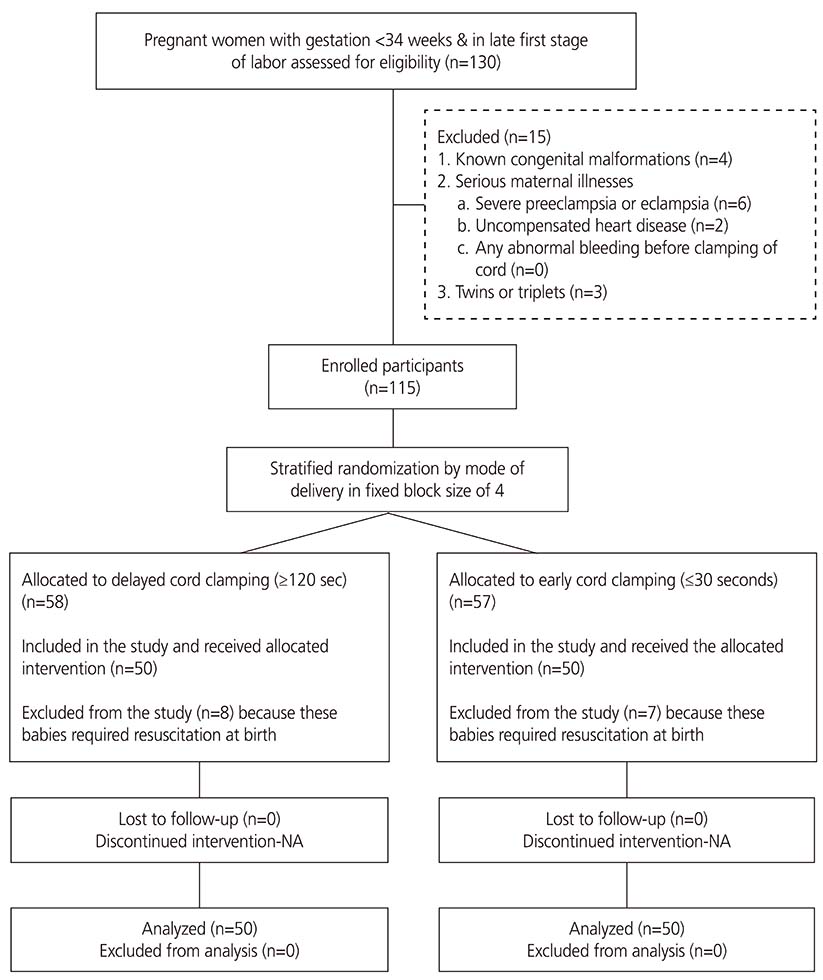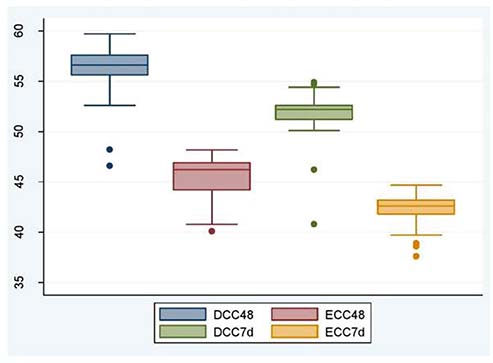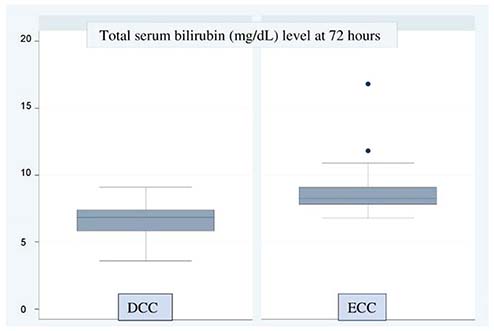Obstet Gynecol Sci.
2018 Nov;61(6):655-661. 10.5468/ogs.2018.61.6.655.
Safety of delayed umbilical cord clamping in preterm neonates of less than 34 weeks of gestation: a randomized controlled trial
- Affiliations
-
- 1Department of Obstetrics and Gynecology, Maulana Azad Medical College and Lok Nayak Hospital, New Delhi, India. anubhuti_rana@yahoo.com
- 2Department of Pediatrics, Maulana Azad Medical College and Lok Nayak Hospital, New Delhi, India.
- KMID: 2426008
- DOI: http://doi.org/10.5468/ogs.2018.61.6.655
Abstract
OBJECTIVE
There is concern regarding the safety of delayed cord clamping (DCC) in babies born at less than 34 weeks' gestation. Therefore, the primary objective of this study was to compare the rates of hyperbilirubinemia and polycythemia during initial 7 days in infants born at less than 34 weeks' gestation and randomized to receive DCC by 120 seconds or early cord clamping (ECC) within less than 30 seconds.
METHODS
One hundred pregnant women were randomly subjected to DCC or ECC at the time of birth in a tertiary referral hospital setting. Blood samples were obtained from each newborn at 48 hours and 7 days for hematocrit measurement. Serum bilirubin levels were estimated once the infant had clinically significant jaundice or at 72 hours. For the statistical analysis, the χ2 test, student's t-test, or Wilcoxon rank sum test was used.
RESULTS
The hematocrit was significantly higher in the DCC group than in the ECC group (P < 0.001). None of the babies had polycythemia. Mean total serum bilirubin level was 6.6 mg/dL in the DCC group and 8.7 mg/dL in the ECC group (P < 0.001). There was no increased risk of hyperbilirubinemia in the DCC group.
CONCLUSION
DCC benefits preterm neonates with no significant adverse effects.
Keyword
MeSH Terms
Figure
Reference
-
1. Weeks A. Umbilical cord clamping after birth. BMJ. 2007; 335:312–313.
Article2. Dawes GS. Fetal and neonatal physiology: a comparative study of the changes at birth. Chicago: Year Book Medical Publishers;1968.3. Pisacane A. Neonatal prevention of iron deficiency. BMJ. 1996; 312:136–137.
Article4. Kugelman A, Borenstein-Levin L, Riskin A, Chistyakov I, Ohel G, Gonen R, et al. Immediate versus delayed umbilical cord clamping in premature neonates born <35 weeks: a prospective, randomized, controlled study. Am J Perinatol. 2007; 24:307–315.5. McDonald SJ, Middleton P, Dowswell T, Morris PS. Effect of timing of umbilical cord clamping of term infants on maternal and neonatal outcomes. Cochrane Database Syst Rev. 2013; 7:CD004074.
Article6. Rabe H, Diaz-Rossello JL, Duley L, Dowswell T. Effect of timing of umbilical cord clamping and other strategies to influence placental transfusion at preterm birth on maternal and infant outcomes. Cochrane Database Syst Rev. 2012; 8:CD003248.
Article7. Sommers R, Stonestreet BS, Oh W, Laptook A, Yanowitz TD, Raker C, et al. Hemodynamic effects of delayed cord clamping in premature infants. Pediatrics. 2012; 129:e667–72.
Article8. World Health Organization. WHO recommendations for the prevention and treatment of postpartum haemorrhage [Internet]. Geneva: World Health Organization;c2012. cited 2014 Jul 30. Available from: www.who.int/reproductivehealth/publications/maternal_perinatal_health/9789241548502/en/.9. Ranjit T, Nesargi S, Rao PN, Sahoo JP, Ashok C, Chandrakala BS, et al. Effect of early versus delayed cord clamping on hematological status of preterm infants at 6 wk of age. Indian J Pediatr. 2015; 82:29–34.10. Gupta R, Ramji S. Effect of delayed cord clamping on iron stores in infants born to anemic mothers: a randomized controlled trial. Indian Pediatr. 2002; 39:130–135.11. AAP Subcommittee on Neonatal Hyperbilirubinemia. Neonatal jaundice and kernicterus. Pediatrics. 2001; 108:763–765.12. Alsafadi TR, Hashmi SM, Youssef HA, Suliman AK, Abbas HM, Albaloushi MH. Polycythemia in neonatal intensive care unit, risk factors, symptoms, pattern, and management controversy. J Clin Neonatol. 2014; 3:93–98.
Article13. Kinmond S, Aitchison TC, Holland BM, Jones JG, Turner TL, Wardrop CA. Umbilical cord clamping and preterm infants: a randomised trial. BMJ. 1993; 306:172–175.
Article14. Ultee CA, van der Deure J, Swart J, Lasham C, van Baar AL. Delayed cord clamping in preterm infants delivered at 34–36 weeks' gestation: a randomised controlled trial. Arch Dis Child Fetal Neonatal Ed. 2008; 93:F20–F23.
Article15. Mercer JS, Skovgaard RL. Neonatal transitional physiology: a new paradigm. J Perinat Neonatal Nurs. 2002; 15:56–75.16. Kaempf JW, Tomlinson MW, Kaempf AJ, Wu Y, Wang L, Tipping N, et al. Delayed umbilical cord clamping in premature neonates. Obstet Gynecol. 2012; 120:325–330.
Article17. Strauss RG, Mock DM, Johnson KJ, Cress GA, Burmeister LF, Zimmerman MB, et al. A randomized clinical trial comparing immediate versus delayed clamping of the umbilical cord in preterm infants: short-term clinical and laboratory endpoints. Transfusion. 2008; 48:658–665.
Article18. Vain NE, Satragno DS, Gorenstein AN, Gordillo JE, Berazategui JP, Alda MG, et al. Effect of gravity on volume of placental transfusion: a multicentre, randomised, non-inferiority trial. Lancet. 2014; 384:235–240.
Article
- Full Text Links
- Actions
-
Cited
- CITED
-
- Close
- Share
- Similar articles
-
- Safety of umbilical cord milking in very preterm neonates: a randomized controlled study
- Delayed Cord Clamping Compared with Cord Milking in Preterm Neonates
- Evaluation of Preterm Delivery between 32(+0)-33(+6) Weeks of Gestation
- Review of Intact Cord Resuscitation
- Comparison of Clinical Outcomes in Late Preterm Infants between Born at 34+0 to 34+6 Weeks and at 35+0 to 36+6 Weeks of Gestation




